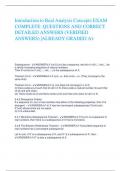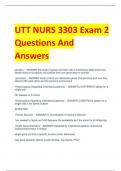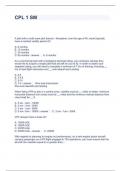Introduction to Real Analysis Concepts EXAM
COMPLETE QUESTIONS AND CORRECT
DETAILED ANSWERS (VERIFIED
ANSWERS) |ALREADY GRADED A+
Subsequence - ✔✔ANSWER✔✔-Let X=(xn) be a sequence, and let n1<n2<...<nk<... be
a strictly increasing sequence of natural numbers.
Then X'=(xnk)=(xn1,xn2,..., xnk, ...) is the subsequence of X.
Theorem 3.4.2 - ✔✔ANSWER✔✔-If (xn)-->x, then (xnk) -->x. (They converge to the
same limit)
Theorem 3.4.4 - ✔✔ANSWER✔✔-(i) (xn) does not converge to x in R,
(ii) there exists 𝛆o>0 such that for all k in N, there exists a natural number nk such that
nk ≥k and |xnk-x|≥𝛆o,
(iii) There exists 𝛆o>0 and there exists (xnk) such that |xnk-x|≥𝛆o for all k in N.
3.4.5 Divergence Criteria
If a sequence X= (xn) of real numbers has either of the following properties, then X is
divergent. - ✔✔ANSWER✔✔-(i) X has two convergent subsequences X'(xnk) and
X''(xrk) whose limits are not equal.
(ii) X is unbounded.
3.4.7 Monotone Subsequence Theorem - ✔✔ANSWER✔✔-If X=(xn) is a sequence of
real numbers, then there is a subsequence of X that is monotone.
3.4.8 The Bolzano-Weierstrass Theorem - ✔✔ANSWER✔✔-A bounded sequence of
real numbers has a convergent subsequence.
Let X=(xn). If X' is a subsequence of X, and X'' is a subsequence of X', then -
✔✔ANSWER✔✔-X'' is also a subsequence of X.
,Limit Superior - ✔✔ANSWER✔✔-The limit superior of (xn) is the infimum of the set V of
v in R such that v<(xn) for at most a finite number of n in N.
Limit Inferior - ✔✔ANSWER✔✔-The limit inferior of (xn) is the supremum of the set of w
in R such that xm < w for at most a finite number of m in N.
3.4.11 Theorem - ✔✔ANSWER✔✔-If (xn) is a bounded sequence of real numbers, then
the following statements for a real number x are equivalent.
(a)x*= lim sup(xn)
(b) If 𝛆>0, there are at most a finite number of n in N such that x*+𝛆<xn, but an infinite
number of n in N such that x*- 𝛆< xn.
(c) If um=sup{xn :n≥m}, then x*=inf{um :m in N}=lim(um).
(d) If S is the set of subsequential limits of (xn), then x*=sup S.
A bounded sequence (xn) is convergent if and only if - ✔✔ANSWER✔✔-lim sup(xn)=lim
inf(xn).
Cauchy Sequence - ✔✔ANSWER✔✔-A sequence X=(xn) of real numbers is said to be
a Cauchy sequence if for every 𝛆 > 0 there exists a natural number H(𝛆) such that for all
natural numbers n,m≥H(𝛆), the terms xn;xm satisfy |xn-xm|<𝛆.
If X=(xn) is a convergent sequence of real numbers, then X is a - ✔✔ANSWER✔✔-
Cauchy sequence.
A Cauchy sequence of real numbers is - ✔✔ANSWER✔✔-bounded.
3.5.5 Cauchy Convergence Criterion - ✔✔ANSWER✔✔-A sequence of real numbers is
convergent if and only if it is a Cauchy sequence.
Contractive sequence - ✔✔ANSWER✔✔-We say that a sequence X=(xn) of real
numbers is contractive if there exists a constant C; 0 < C < 1, such that |xn+2-
xn+1|≤C|xn+1-xn| for all n in N. The number C is called the constant of the contractive
sequence.
3.5.8 Theorem - ✔✔ANSWER✔✔-Every contractive sequence is a Cauchy sequence,
and therefore is Convergent.
If X=(xn) is a contractive sequence with constant C; 0 < C < 1, and if x*=lim X, then -
✔✔ANSWER✔✔-(i) |x*-xn| ≤ Cn-1/1-C |x2 -x1|;
(ii) |x*-xn|≤ C/1-C |xn-xn-1|
Tends to ∞ or -∞ - ✔✔ANSWER✔✔-Let (xn) be a sequence of real numbers.
, (i) We say that (xn) tends to ∞, and write lim(xn)=∞, if for every a in R there exists a
natural number K(a) such that if n ≥ K(a), then xn > a.
(ii) We say that (xn) tends to -∞, and write lim(xn)=-∞ , if for every b in R there exists a
natural number K(b) such that if n ≥ K(b), then xn < b.
Properly divergent - ✔✔ANSWER✔✔-We say that (xn) is properly divergent in case we
have either lim(xn)=∞ or lim(xn)=-∞.
3.6.3Theorem - ✔✔ANSWER✔✔-A monotone sequence of real numbers is properly
divergent if and only if it is unbounded.
(a) If (xn) is an unbounded increasing sequence, then lim(xn)=∞.
(b)If (xn) is an unbounded decreasing sequence, then lim(xn)=-∞.
3.6.4Theorem - ✔✔ANSWER✔✔-Let (xn) and (yn) be two sequences of real numbers
and suppose that xn ≤ yn for all n in N:
(a) If lim(xn)=∞, then lim(yn)=∞.
(b) If lim(yn)=-∞, then lim(xn)=-∞
Let (xn) and (yn) be two sequences of positive real numbers and suppose that for some
L in R; L>0, we have, lim(xn/yn)=L. - ✔✔ANSWER✔✔-Then lim(xn)=∞ if and only if
lim(yn)=∞.
Cluster point - ✔✔ANSWER✔✔-Let A ⊆ R. A point c in R is a cluster point of A if for
every 𝛿>0 there exists at least one point x in A; x≠c such that |x -c|<𝛿.
This definition is rephrased in the language of neighborhoods as follows: A point c is a
cluster point of the set A if every 𝛿-neighborhood V𝛿(c)=(c-𝛿, c+𝛿) of c contains at least
one point of A distinct from c.
A number c in R is a cluster point of a subset A of R if and only if - ✔✔ANSWER✔✔-
there exists a sequence (an) in A such that lim(an)=c and an≠c for all n in N.
Limit of f at c - ✔✔ANSWER✔✔-Let A⊆R, and let c be a cluster point of A. For a
function f : A→ R, a real number L is said to be a limit of f at c if, given any 𝜀>0, there
exists a 𝛿>0 such that if x in A and 0 < |x-c| <𝛿, then |f(x) - L| <𝜀 .
If f :A→R and if c is a cluster point of A, - ✔✔ANSWER✔✔-then f can have only one
limit at c.
4.1.6 Theorem - ✔✔ANSWER✔✔-Let f : A→R and let c be a cluster point of A. Then the
following statements are equivalent.
(i) limf(x)=L. x→c







